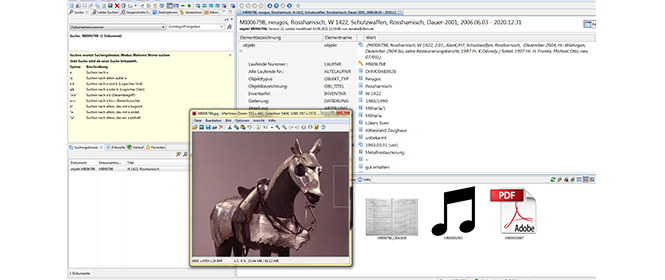
Many Objects, Countless Tasks, a Single Database
Brigitte Reineke | 11 August 2021
The internal object database at the Deutsches Historisches Museum is an essential tool for documenting the dismantling of the permanent exhibition. Dr. Brigitte Reineke, Head of Central Documentation, explains what all goes into a single database – from the object records of each exhibit to the many related tasks that are performed.
More than 5,500 collection objects were on display in the permanent exhibition German History from the Middle Ages to the Fall of the Berlin Wall, located in the Zeughaus. This included a set of medieval armour for horse and rider, Martin Luther’s German Catechism, a portrait of Napoleon I from the workshop of François Gérard, a Maurer Union car from the late 19th century, and an Enigma cipher device used by the German Wehrmacht, as well as a Bundeswehr infantry uniform jacket and a brochure detailing the military readiness of East Germany, both from the 1950s. Each object is subject to different climate-control conditions, whether presented in a showcase, hung on the wall, or placed free-standing in the room. Each object represents a different moment in time within the historical sweep of the permanent exhibition. But they all have one thing in common: they are recorded in the Deutsches Historisches Museum’s internal object database, where all things are treated equally. Whether the object in question is a priceless painting from the 15th century or a cheap mass-produced toy car from the 1970s is irrelevant. There is an entry dedicated to each one, comprising all conceivable information about it – a ‘biography of the museum object’, if you will. In addition to the basics – a physical description, its date, details about its production, and any illustrations –the database also contains information on any cleaning or conservation treatments it might have had, its origin and original use context, its loan history, and even technical data such as condition reports, its former physical location in the Zeughaus, and a list of the objects it was contextualized with there.
Whether it is the barding (horse armour) or the brochure on East German defence, what gets recorded in the database for each object is the exhibition chapter, room, and exact location (the display case number or wall allotment). As a result, everyone involved can retrieve this information. For example, the Military Collection management staff can plan ahead and determine where in storage the variously sized individual pieces of the horse armour will be stored once the permanent exhibition is dismantled, while the metal conservator determines how to optimally pack it for transport. The database serves as a central tool for internal planning – also when it comes to dismantling the permanent exhibition. Staff from every museum department work hand in hand and look to the central collection database for the detailed information necessary for completing their specialized tasks.
The director and registrars of the permanent exhibition thus have an overview of all relocations. Together with the head of the conservation studios, they plan how to dismantle each object in accordance with its requirements. Which objects need to be packed and transported first, in order to make room for other ones that are more difficult to manoeuvre? Should the large display case featuring the barded horse be broken down first? Is a climate-controlled crate necessary for transporting the painting of Napoleon I? Do we even have one available right now?
From the collection database object lists are generated for each section of the permanent exhibition, sorted by exact location. Whenever a display case is opened or an object is removed from the museum’s walls, the registrars record it here. Staff members responsible for the collection storage in turn ensure that each object, once returned, is allocated a fixed location there. This way, everyone knows where each object is every step of the way – on its journey from the Zeughaus to the collection storage.
The Central Documentation staff oversees this massive relocation project by supervising and correcting database entries, ensuring consistency, and fulfilling the demands that arise in preparation of such a mammoth project: they define new rules for database entries, create object lists that adhere to certain criteria, implement and make available new report templates. Everything is centralized in a single place, or rather, database – a massive undertaking, indeed!